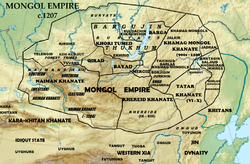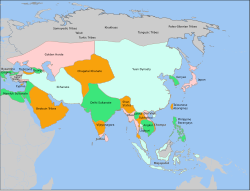World History empires name meanings study guide: Difference between revisions
| Line 11: | Line 11: | ||
** cultural diffusion = the spreading and mixing of cultures, populations, technologies, disease, etc. | ** cultural diffusion = the spreading and mixing of cultures, populations, technologies, disease, etc. | ||
* we will see in this review over and over how many conquerors become more like the people and places they conquered than what / who they were at the start of the conquest | * we will see in this review over and over how many conquerors become more like the people and places they conquered than what / who they were at the start of the conquest | ||
=== Standardization & unity === | |||
* empires rule and spread rule through the process of standardization | |||
* while we think of standardization as making things the same, it can also mean treating disparate groups equally | |||
** i.e., under legal or political standards of either tolerance or favor | |||
** in such systems, different groups may be treated unequally, but in a standardized system, the law or governance treats them consistently, if not equally | |||
*** i.e., Islamic legal distinctions between Muslims and non-Muslims | |||
**** different taxes, military service, etc. | |||
* typical methods of standardization and unity include | |||
** writing / language | |||
** laws | |||
** taxation | |||
** currency/ money | |||
** road & canal building | |||
** official religion and/or religious tolerance | |||
== China empires/ dynasties == | == China empires/ dynasties == | ||
| Line 295: | Line 311: | ||
|} | |} | ||
== | == Islamic empires == | ||
{| class="wikitable" | {| class="wikitable" | ||
!Name | !Name | ||
| Line 303: | Line 319: | ||
!Notes | !Notes | ||
|- | |- | ||
|Ottoman Empire | |Notes: | ||
| | |||
* "Caliphate" from "Caliph" which means successor of Muhammad | |||
** the Caliph was considered ruler of the entire Muslim world (called the "umma" for "follower of Islam") | |||
*** note that "umma" transcends ethnic/ tribal alliances | |||
* "Islam" means "submit to God" | |||
* "Sharia" is the Islamic law | |||
** includes civil, political and criminal codes governing crime, family, trade, education, daily life and routines | |||
* "Sunni" = "community" | |||
** started by Muhammad's father-in-law, Abu Bakr | |||
** Sunnis follow Caliphs | |||
* "Shi'a" or "Shiite" is from "Shi'aat Ali" for "followers of Ali" | |||
** Ali was Muhammad's son-in-law and the husband of his daughter, Fatima | |||
| | |||
| | |||
| | |||
|- | |||
|First Caliphate | |||
| | |||
* established by Abu Bakr, 632, who reunited Arabia under Islam following Muhammad's death | |||
** under the idea, "Muhammad dead, Allah alive" | |||
** | |||
| | |||
| | |||
| | |||
|- | |||
| | |||
=== Umayyad Caliphate === | |||
| | |||
* 2nd major Caliphate (Sunni) | |||
| | |||
| | |||
| | |||
* established capital at Damascus in Syria (near Middle East) | |||
* spread Islam and Arabic | |||
** conquered Persia and extended reach to Indus River (modern Pakistan) | |||
** expanded across North Africa and into Spain | |||
|- | |||
| | |||
=== Abbasid Caliphate === | |||
| | |||
* Abu Al-Abbas | |||
|750-1258 | |||
|Lower Middle East | |||
| | |||
* conquered Damascus to create new Caliphate | |||
* moved capital ot Baghdad | |||
* included non-Arabs (especially Persians) | |||
* attacked by Mogols and fell to Seljuk Turks | |||
|- | |||
|Turks/ Seljuk Turks | |||
| | |||
| | |||
| | |||
| | |||
|- | |||
| | |||
=== Ottoman Empire === | |||
| | |||
| | |||
| | |||
| | | | ||
|- | |||
| | | | ||
=== Safavid Empire === | |||
| | | | ||
* Persian | |||
|1453-1629 | |||
|Persia | |||
| | | | ||
* note the date, 1453 = the year of the fall of Constantinople, during which time the Ottmans were focused on expanding westward | |||
|} | |} | ||
[[Category:World History]] | [[Category:World History]] | ||
[[Category:AP World History]] | [[Category:AP World History]] | ||
[[Category:Social Studies skills]] | [[Category:Social Studies skills]] | ||
Revision as of 18:44, 4 January 2023
Goal of this article is to help students identify context and historical recollection via definitions of historical names and terms
- along with memorizing names, places (map literacy) and dates
- historical knowledge and test-day recollection can be enhanced through etymology, or word origins of key historical places, empires or dynasties
Concepts & notes[edit | edit source]
Cultural Diffusion: are conquerors eventually conquered by the conquered?[edit | edit source]
- a common thread to studies of rise and fall of empires and dynasties is cultural diffusion
- cultural diffusion = the spreading and mixing of cultures, populations, technologies, disease, etc.
- we will see in this review over and over how many conquerors become more like the people and places they conquered than what / who they were at the start of the conquest
Standardization & unity[edit | edit source]
- empires rule and spread rule through the process of standardization
- while we think of standardization as making things the same, it can also mean treating disparate groups equally
- i.e., under legal or political standards of either tolerance or favor
- in such systems, different groups may be treated unequally, but in a standardized system, the law or governance treats them consistently, if not equally
- i.e., Islamic legal distinctions between Muslims and non-Muslims
- different taxes, military service, etc.
- i.e., Islamic legal distinctions between Muslims and non-Muslims
- typical methods of standardization and unity include
- writing / language
- laws
- taxation
- currency/ money
- road & canal building
- official religion and/or religious tolerance
China empires/ dynasties[edit | edit source]
| Name | Name definition | Dates | Region | Notes |
|---|---|---|---|---|
| Chinese dynasties follow four general categories of name origins: |
|
| ||
Yuan Dynasty[edit | edit source] |
|
1271–1368 |
| |
Ming Dynasty[edit | edit source] |
|
1368-1644 |
| |
Qing Dynasty[edit | edit source] |
|
1644–1911 | Manchuria, China |
|
Mongol empires[edit | edit source]
| Name | Name definition | Dates | Region | Notes | |
|---|---|---|---|---|---|
Mongol Empire[edit | edit source] |
|
1206–1368 | Eurasia |

 | none |
Yuan Dynasty[edit | edit source] |
see above under China dynasties for Yuan | 1271–1368 | |||
Golden Horde (Mongol)[edit | edit source] |
|
| |||
Chagatai Khanate[edit | edit source] |
|
1242-1347 /
1347-1487 |
| ||
Ilkhanate Khanate[edit | edit source] |
|
1256–1335 | Persia & northern Middle East/ Anatolia |

|
Europe monarchies/ empires[edit | edit source]
India empires[edit | edit source]
| Name | Name definition | Dates | Region | Notes |
|---|---|---|---|---|
| Timurid Empire |
|
1370–1507 | Persia (Iran), central Aisa, northern India |
|
| Mughal Empire |
|
1526–1857 |
Islamic empires[edit | edit source]
| Name | Name definition | Dates | Region | Notes |
|---|---|---|---|---|
| Notes: |
|
|||
| First Caliphate |
|
|||
Umayyad Caliphate[edit | edit source] |
|
| ||
Abbasid Caliphate[edit | edit source] |
|
750-1258 | Lower Middle East |
|
| Turks/ Seljuk Turks | ||||
Ottoman Empire[edit | edit source] |
||||
Safavid Empire[edit | edit source] |
|
1453-1629 | Persia |
|
